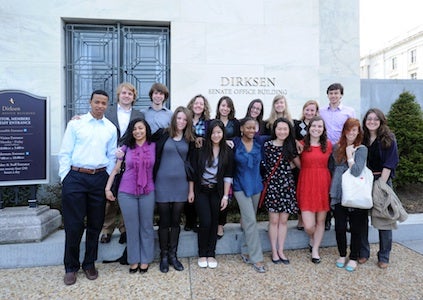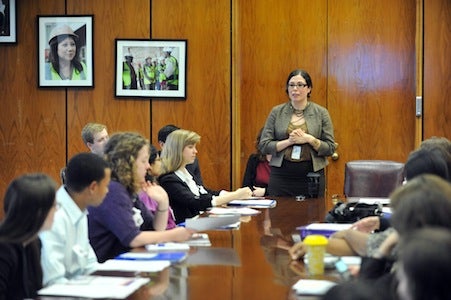Julia Hubbell Reflects on Worker Justice Alternative Spring Break
Posted in Student Leaders Worker Justice DC
Read Julia Hubbell’s reflections on her time leading our 2012 Worker Justice DC alternative break trip.
“Never doubt that a small group of thoughtful, committed citizens can change the world. Indeed, it is the only thing that ever has. ” — Margaret Mead
Between the picket lines and the posters, the committee meetings and the early morning coffee runs, this is the essential lesson of the Kalmanovitz Initiative. A small group of thoughtful, committed citizens on Georgetown campus are coming together to discover the method by which they can become agents of change. “Go forth and set the world on fire,” as St. Ignatius said.The Kalmanovitz Initiative sponsored an Alternative Spring Break for just such a group of Georgetown students. I had the good fortune to participate, and it was transformative.
Sixteen other students and I spent the week engaging with the community of DC in order to better understand its history and its needs. For those unfamiliar with it, I suggest a trip to BloomBars—a Colombia Heights-based initiative to provide an open space for the neighborhood to meet, with free lessons in guitar, arts and crafts for kids, and a drum circle. It boasts purple walls and a boat in the ceiling (yes, in—don’t ask me how).
We also had the chance to meet with representatives from the Department of Labor, the AFL-CIO, the Senate Health, Education, Labor, and Pensions committee, think tanks such as the Economic Policy Institute, and the National Labor Relations Board. There is no doubt that the lessons and experiences of these people helped us understanding of the complexity of labor.
And yet, with all of these people in all these official positions—each of whom was an inspiring example of a life of service—yet even still, the best experience was direct action and direct interactions. We traveled one morning to speak with the day laborers outside a local Home Depot. It was the coldest day in a while, with little white flakes sprinkled here and there, and after fifteen minutes, I wanted to go back in the car. But we stayed because the men stayed, rain or snow or shine, to scrape a living from the dregs of the construction industry. I met a man from Guatemala who had been in America for fifteen years and was still standing on this corner, looking for obliging contractors to hire him. What was so broken, I asked myself, that fifteen years wasn’t sufficient to create the American Dream? We talked to the recently unionized workers from our campus dining hall, who had just signed a contract after a long fight. How can a fifty cent raise be so deeply divisive?
These are the questions we encountered on the trip, and I’m sorry to tell you we didn’t find the answers. Maybe, however, it is because the answers aren’t out there to be found. Maybe we have to create them. The best thing the trip did for us, better than the meetings and the panels and the (sometimes free) cupcakes, was the motivation to create solutions where there weren’t any. We want to be those agents of change. We hope to go and set the world on fire, and thanks to the Kalmanovitz Initiative, we now have the tools to do that.


